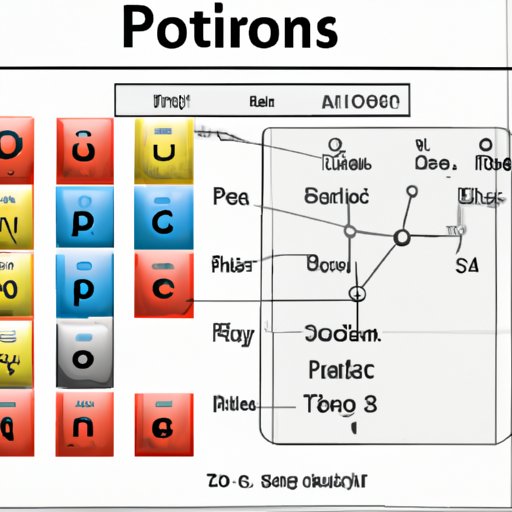
I. Introduction
Understanding the structure of atoms is essential for learning chemistry, as it helps us decipher the building blocks of matter. Within an atom, protons, neutrons, and electrons play important roles, and understanding how to locate them is key to understanding the properties of an element. In this article, we’ll explore the ins and outs of finding protons, neutrons, and electrons in an atom.
II. The Beginner’s Guide to Finding Protons, Neutrons, and Electrons
Before diving into the process of finding protons, neutrons, and electrons, it’s important to understand what they are and how they fit into the atomic structure. Protons are positively charged particles located in the nucleus of the atom, while neutrons are neutrally charged particles also located in the nucleus. Electrons, on the other hand, are negatively charged particles that orbit the nucleus in shells.
The atomic structure is made up of a nucleus, which houses protons and neutrons, and electrons orbiting it. Protons and neutrons have a similar mass, while electrons are significantly lighter. The number of protons in an atom determines the atomic number, which in turn determines which element the atom belongs to on the periodic table.
Basic methods for finding the numbers of protons, neutrons, and electrons include using the periodic table, as well as looking at the atomic number and mass number of the element.
III. Mastering the Art of Atomic Structure: A Step-by-Step Guide to Locating Protons, Neutrons, and Electrons
While basic methods can provide a rough estimate of the number of protons, neutrons, and electrons, a more detailed process can provide more accurate results. To find the number of protons, look up the element on the periodic table and identify the atomic number, which is the number of protons in the nucleus.
Neutrons are found by subtracting the atomic number from the mass number listed on the periodic table. Isotopes, which have varying numbers of neutrons, can be found by looking at the mass number instead of the atomic number.
Electrons can be more challenging to locate, as their orbitals are constantly changing. However, the number of electrons in an atom can be determined using the same process as protons. For example, an atom of carbon with an atomic number of 6 will have six electrons.
IV. Getting to Know Your Elements: How to Find Protons, Neutrons, and Electrons in Any Atom
Using the step-by-step process outlined in the previous section, we can find the numbers of protons, neutrons, and electrons for any given atom. For example, an atom of oxygen has an atomic number of 8, indicating it has 8 protons. The mass number, found on the periodic table, is 16. This means oxygen has 8 neutrons (16 – 8 = 8) and 8 electrons.
By following this process, the numbers of protons, neutrons, and electrons for any atom can be determined, allowing us to better understand the properties of an element.
V. Finding the Building Blocks of Chemistry: A Comprehensive Overview of Protons, Neutrons, and Electrons
Protons, neutrons, and electrons contribute to the properties of an element in a number of ways. The number of protons determines the atomic number and, by extension, the element’s properties, such as its reactivity and appearance.
Neutrons can affect an element’s stability and can be used to create isotopes for various applications, such as medical imaging and radiation therapy.
Electrons play a crucial role in chemical reactions, as they are involved in the sharing and transfer of electrons between atoms, which creates chemical bonds. The number of electrons can also determine an element’s reactivity, with elements in the same group on the periodic table having similar electron configurations and reactivity.
VI. Exploring Atomic Structure: How to Identify the Number of Protons, Neutrons, and Electrons in an Element
More advanced techniques can provide even more precise information on the atomic structure of an element. Electron configuration, for example, can provide information on the number and arrangement of electrons in an atom’s shells. Mass spectrometry can provide information on the mass and abundance of isotopes in an element.
These techniques are used in various fields, such as forensics, environmental science, and medical research, to identify substances and their compositions.
VII. Cracking the Code of the Atom: Tips and Tricks for Finding Protons, Neutrons, and Electrons
While finding protons, neutrons, and electrons may seem daunting, there are a few tips and tricks that can make the process easier. For example, remembering that the atomic number is the number of protons, and the mass number is the sum of protons and neutrons, can simplify the process.
When in doubt, reference the periodic table, which houses a wealth of information on each element, including its atomic number, mass number, and electron configuration.
VIII. Conclusion
Understanding the structure of atoms is integral to learning chemistry, and finding protons, neutrons, and electrons is essential to understanding the properties of an element. By following the step-by-step process outlined in this article, anyone can identify the numbers of protons, neutrons, and electrons in an atom.
Remembering the importance of these particles, and the role they play in chemical reactions and scientific research, is crucial to furthering our understanding of the world around us.




